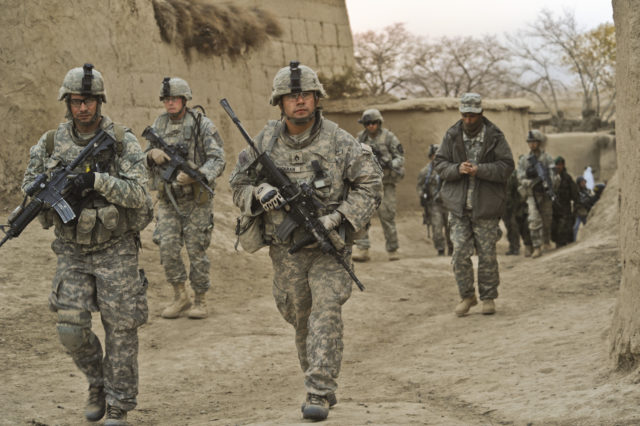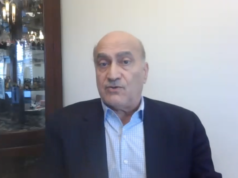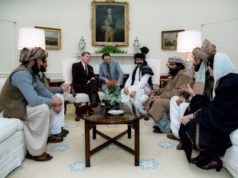
Even with the defeat of ISIS in both Iraq and Syria, we are far from achieving our overall U.S. objectives in the Middle East. The Iranian Crescent is clearly expanding and threatening to encircle our traditional allies and friends. Complicating matters is Russia’s resurgence as a power broker, not only in Syria and Iran, but also its renewed military and economic relations with Egypt and the emergence of a new jihadist axis including Turkey, Qatar, and Iran.
With the killing of the former Yemeni president Ali Abdullah Saleh, there is no clear path forward in resolving the Yemen civil war. While Saleh was a divisive figure, he was also clever enough to broker a settlement. When he announced an offer to link up with the Saudis, it sealed his demise. The recent firing of a likely Iranian-made ballistic missile by the Houthi rebels at the Riyadh International Airport and the Saudi royal court at al-Yamama palace has added a new dimension to that crisis. Clearly, a blockade needs to be set up to intercept arms smuggling by Iran. We should also assist the Saudi coalition (Egypt, UAE, Kuwait, Bahrain, and Sudan) to retake the Port of Hodeidah, which would be a tremendous psychological blow to the Houthi rebels and Iran.
Defining U.S. Interests
With the United States being challenged throughout the world, a realistic, disciplined strategy should be adopted that is based on our core vital interest, including:
• Preventing Iran from achieving nuclear weapons capability has been one of our vital interests. The Iranian regime has been actively seeking nuclear weapons capability since the late 1980s, primarily clandestinely but thanks to the Obama administration, with an international veneer of legitimacy. However, under the Obama administration, this objective was severely undercut with the five-party, unsigned “Joint Comprehensive Plan of Action” (JCPOA). Regretfully, with North Korea being the off-site laboratory for Iran, it must be assumed that Iran already has a nuclear weapon capability. Unconfirmed reports that North Korea covertly shipped three nuclear warheads to Iran underscores this danger. Therefore, our objective now must be to prevent Iran from deploying any nuclear capability against the United States and our allies.
• Roll back Iranian geo-strategic hegemony in the region. As a first step, disrupt Iran’s attempt to establish a land bridge from Tehran to the Mediterranean Sea and Lebanon and disrupt its attempts to encircle the Arabian Peninsula with puppet regimes.
• Ensure the survival of Israel. This will require strengthening the bilateral relationship, both diplomatically and militarily.
• Ensure freedom of the seas including keeping open strategic straits, e.g., Hormuz and Bab-el-Mandeb.
• Support an independent Kurdistan. Not only were they our loyal allies in helping us defeat ISIS, but an independent Kurdistan is key to disrupting Iran’s land bridge to Lebanon. The 1916 Sykes-Picot Treaty is dead. We must recognize realities on the ground. Neither Iraq nor Syria will ever be able to exercise control over their former sovereign territory. An independent Kurdistan is a dagger in the heart of Iranian objectives.
• Support and actually lead efforts for regime change in Tehran.
• Reinforce our alliances with our regional friends and allies.
Supporting Non-Jihadi Forces
It must be understood that Baghdad, Beirut, and Damascus are all Iranian puppet regimes. Hezbollah and the various Shiite jihadi militia groups in both the former Iraq and Syria are all proxy militias under the Iranian Revolutionary Guard Corps (IRGC)/Qods Force Command. As part of our strategy, we must refuse to cooperate with them or provide them any support. We need to work with and support the non-jihadi Sunni forces in the region to confront and degrade the Iranian militias.
We should also work with the National Council of Resistance of Iran (NCRI), the largest, oldest and best organized of all Iranian opposition groups, as well as with Israel to monitor – and when the time comes, to destroy – Iran’s clandestine nuclear weapon program. This is key to preventing Iran from actually deploying its nuclear weapons, whether in a test demonstration scenario – or an actual attack. We must be prepared to destroy Iran’s nuclear infrastructure, if necessary.
We need to intensify the Trump administration’s developing relationship with the Kingdom of Saudi Arabia. We need to ensure that Crown Prince Mohammed bin Salman’s objectives and vision coincide with ours and those of our allies (Israel). We need to work with MbS and support his efforts to modernize the Kingdom while at the same time curbing the power of the Wahhabi clergy and root out corruption.
Cutting off the LAF
The recent “two-step” by the Lebanese President Saad Hariri remains confusing as to his actual intentions as well as relationship with the Saudis. He first showed up in Riyadh in mid-November 2017 to announce his resignation as prime minister of Lebanon because Iran and Hezbollah effectively control Lebanon. That was useful in actually exposing the true situation on the ground. The subsequent withdrawal of his resignation upon his return to Beirut, while confusing, nevertheless changed nothing with regard to Iran and Hezbollah’s control of the Lebanese Armed Forces (LAF). The LAF is a wholly owned subsidiary of the IRGC and controlled by Hezbollah, so it makes absolutely no sense for the U.S. to continue to provide it with military equipment. Accordingly, the recently announced $120 million worth of military equipment that the Trump administration is planning to transfer to the LAF must be cancelled. The same with our bribery money to the Palestinian Authority, which refuses to recognize Israel’s legitimacy and continues to make payment to terrorists’ families.
Our strategy must also confront the new emerging jihadist axis of Turkey, Qatar, and Iran. This alliance is committed to regional objectives counter to those of America and our allies.
Pakistan in Afghanistan
As can be seen, the United States has no core compelling vital national security interests in Afghanistan. It is a primitive, tribal Islamic society and cannot be modernized in any meaningful Western sense for the foreseeable future. Therefore, we should not waste any more of our national treasure on this corrupt society. It is not a question of whether or not the current U.S. counterinsurgency strategy in Afghanistan will succeed, but rather to acknowledge that the strategic environment makes success virtually impossible. This is due to the fact that Pakistan, upon which the outcome of our counterinsurgency strategy depends, views Afghanistan as a client state with only the thinnest veneer of sovereignty, and has regional plans markedly different from those of the United States and NATO.
As Col. Larry Sellin, USA (ret.) has pointed out many times, Pakistan regulates the operational tempo through its support of the Taliban and therefore, effectively controls how our troops are employed in Afghanistan. Additionally, because U.S. supply lines for those troops pass through Pakistan, it also wields an effective choke hold on our operations there. Our counterinsurgency tactics place our forces at the same tactical level of the Taliban. Consequently, we are playing to the strengths of the enemy rather than our own. According to Sellin, Pakistan will always do just enough to prevent the United States and NATO from ever reaching the point of ensuring a stable and secure Afghanistan.
Pakistan now sees China as the future dominant power in South Asia. The Chinese are investing heavily in the Chinese-Pakistan Economic Corridor (CPEC) which is the regional linchpin of China’s global Belt and Road Initiative (BRI). CPEC is more than economic. It will also help China to control military choke points, such as from a likely new naval base in Gwadar. Its proximity to the Straits of Hormuz, through which most of China’s energy flows, should not be overlooked. It should also be noted that the Chinese are expanding the Gwadar International Airport to handle military flights. Clearly the current U.S. counterinsurgency strategy in Afghanistan is ill-suited for future strategic challenges in the region.
The Role of Balochistan
The strategic center of gravity has actually shifted from Afghanistan to the Pakistani province of Balochistan, which is not only critical to China’s $46 billion investment in CPEC, but is now the home of an extensive Taliban support infrastructure and a breeding ground for transnational terrorism. A shift of Balochistan in the direction of its former secular independent status would drive a geo-political stake into the heart of radical Islam, obviate Pakistan’s influence in Afghanistan and shatter China’s plan to economically dominate South Asia and control the vital Indian Ocean sea lanes to the Persian Gulf and Suez Canal.
As can be seen, our overall strategy for the Middle East and South Asia must be framed by our core vital interests. Besides the necessary political and diplomatic efforts, our strategy must be based on a balance of power with our regional allies to prevent regional hegemony by any one country (Iran, Russia, or China). This will require a deployed force structure that enables us to conduct surgical strikes with the effective use of special forces, combined with the non-jihadist Sunni-Shia elements to thwart plans to keep off-balance any nation that threatens U.S. regional interest.
Admiral James Lyons, USN (ret.) served as the Commander of the U.S. Pacific Fleet.





